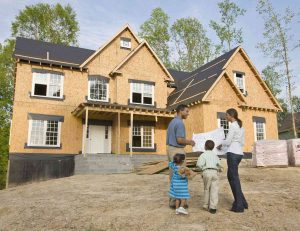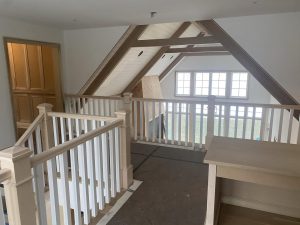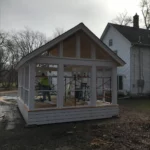Step 1: Determine the Total Cost of Your New Home Build
Before getting a loan, you should have a good idea of how much your new home will cost in total. This includes the cost of materials, labor, land, permits, fees, and any other costs related to the project. Estimating these costs can be hard because fees for things like permits and zoning vary from place to place. Also, the quality and complexity of the home being built can have a big effect on the cost of materials and labor. Do some research on local building costs to make sure your estimates are correct. You can also get a better idea of what to expect when budgeting for building your new home.


Step 2: Assess Your Financing Options
An important part of building a new home is figuring out the right type of financing. Most people are familiar with traditional mortgages, but there are also construction loans as a better option. Let’s explore this!
Construction Loans
Construction loans are made specifically to pay for the costs of building a new home. Most home construction loans are short-term. Here, the borrower only has to pay interest on the money that was actually borrowed at different stages of construction. Some lenders may also offer lower interest rates or other perks to people who get a construction loan to pay for building a new home.
Types of Construction Loans
Construction-Only Loan: A construction-only loan is a short-term way for people to get the money they need to build a new home. With these loans, the lender gives the borrower money right away to pay for materials and labor while the house is being built. When the building is done, the borrower may need to get a different loan to pay off the construction loan.
Construction-to-Permanent Loan: With a construction-to-permanent loan, the money is given out in stages as the building is built. Once the house is finished, the loan is changed into a regular mortgage with a fixed rate of interest and length of time to pay it back. This means that the borrower doesn’t have to get another loan when construction is done.
Renovation Loan: A renovation loan is a type of loan that is used to pay for the cost of making improvements to an already-owned home. The money is given out in stages as the construction goes on. When the work is done, the loan is turned into a regular mortgage.
Owner-Builder Loan: An owner-builder loan is available if you are building your own home and acting as your own contractor. With an owner-builder loan, the lender gives the borrower a loan directly. This loan can be used to pay for both materials and labor.
End Loan: An end loan is a specific kind of mortgage that can be used to pay off the construction loan once the house is built. This means that there is no longer a need to get separate funding to finish building.
Step 3: Improve Your Credit Score and Financial Health
Improving your credit score and overall financial health is a key step to getting a loan for building a new home. If you want to borrow money, having a good score will help you get the best rates. Also, think about your budget and financial health.
Tips to increase your credit score
- Don’t be late with your bills. Your score can go down if you pay your bills late, so make sure to pay them all on time and in full.
- Pay off any debts or accounts with debt collectors. Your credit score will go up over time if you pay off any old debts or collections accounts.
- Keep your credit card and other revolving credit balances low. High balances can hurt your score, so try to keep any balances you already have as low as you can.
- Make sure your credit report is correct. Errors on your credit report can hurt your score, so you should check it often and dispute any mistakes you find.
- Cut down on new credit checks. When you apply for a loan or line of credit, your credit report is checked. Your score can go down if you make too many inquiries, so try to limit them as much as you can.
Assessing your financial health and budgeting
When it comes to financing a new home construction, it’s important to look at your finances and make a budget. You can make a plan to build your dream home if you look at your income, expenses, debt, savings, and credit score. Here are some ways to figure out how well off you are financially:
- Make sure you have money saved for emergencies.
- Make a budget and keep track of what you spend.
- Pay down any debts you already have.
- Put away more money.
- Pay your bills on time to build your credit.
Step 4: Save for a Down Payment and Closing Costs


Saving up for a down payment and closing costs is a key part of getting a loan to build a house. A down payment is a lump sum of money that the lender needs upfront. It is usually between 10 and 20% of the total loan cost. Closing costs are extra fees that come with getting a loan. They can vary a lot depending on the lender, the laws in the area, and other factors. To get financing for new home construction, both the down payment and the closing costs must be paid upfront. Here are two important queries and their answers.
How much should you save for a down payment?
How much you need to save for a down payment depends on what kind of loan you are getting. In general, FHA loans require a down payment of at least 3.5% of the purchase price, while conventional loans require a down payment of between 5% and 20%. Before you decide how much to save for a down payment, you should do a lot of research on your options.
What are closing costs, and how much should you expect to pay?
When a loan is closed, the lender charges fees called “closing costs.” Closing costs often include title insurance, attorney fees, appraisal fees, and other fees. How much you have to pay for closing costs depends on the lender and the type of loan you get. Closing costs are usually between 2% and 5% of the total cost of the loan. When figuring out how much money you need to save to build your home, it’s important to include closing costs. Also, some lenders may have programs that cover all or part of your closing costs, so it’s important to ask about these options before you apply for a loan.
Step 5: Choose Your Lender and Loan Terms
Choosing your lender and loan terms is another important step in getting a home loan. Before you can get a loan for your new building, you’ll need to research and compare lenders to find the one that fits your needs the best. It’s also important to know what the loan terms and rates of interest are, so you can choose a loan with knowledge.
Researching and Comparing Lenders
When looking for the right lender, it’s important to compare options based on things like interest rates, fees, customer service, and reputation. You should also read reviews from people who have used each lender in the past. This will give you an idea of what it was like for them. Also, some lenders may have special programs and perks for new construction loans, so it’s important to ask about those as well.
Understanding Loan Terms and Interest Rates
The terms of your loan and the interest rate you get will depend on things like your credit score, how much money you make, how much debt you have, and more. When choosing a loan, it’s important to know what the terms are and how the rate of interest is set. This will make sure you get a loan that fits your needs and lets you build your dream home on time and on budget.
Step 6: Applying for a Construction Loan
You can apply for a construction loan once you’ve chosen a lender and figured out the terms of your loan. This is a very important step because it will tell you how much you can borrow to build your new home. In most cases, the application process involves sending in different forms and documents, such as a statement of income, tax returns, credit reports, and more. Before you apply for a loan, you should make sure you know what it takes to get it. This way, you can make sure you have all the documents you need.
The Application Process and Required Documents
To apply for a construction loan, you will need to show proof of your income and creditworthiness, as well as other forms like tax returns, bank statements, and more. Before you apply, you should know what documents you might need to make sure you have everything in order.
Working with a Qualified Builder or DIY Home Build Loans
How much money you can borrow to build a house also depends on whether you hire a professional builder or do it yourself. Most lenders will only give you money for your building project if you work with a professional builder. But some lenders offer special loans for do-it-yourself projects if you meet certain requirements.
Possible Options for No Money Down
Depending on your credit score and other things, some lenders may offer construction loans with no money down. This is a great option if you don’t have enough money saved for a down payment or closing costs. But before you apply for a loan, you should make sure you understand the terms and that you can easily meet the loan’s requirements.


Step 7: Managing Your Construction Loan
Once you have a construction loan, it is important to know how to work with your builder and manage the loan. The drawing process is how you will get access to the money and pay your builder while the house is being built. Knowing when your loan amount will be paid out will help you plan ahead. It’s also important to figure out how to deal with any problems with the schedule or budget. This can help you keep your project on track and make sure you don’t go over budget.
The Drawing Process and Paying Your Builder
During the construction process, you will use the money from your construction loan throughout the design process. During this step, you or your home builder will send in drawings for things like framing, plumbing, and electrical work. Your lender will look over the requests for draws and give your builder the money as needed. It’s important to know how this works so you can plan ahead for when you need to pay your builder.
Understanding Your Loan Disbursement Schedule
Your loan disbursement schedule shows when different payments will be made while your house is being built. It’s crucial to comprehend this schedule, which the lender typically provides, so you know when payments are due. If you know this, you can plan your budget and make sure all of your bills are paid on time.
Navigating Any Timeline or Budget Issues
When you’re managing your construction loan, it’s important to stay on top of any problems with time or money. Any delays or costs you didn’t expect can cause problems, so it’s important to know about them early and take steps to fix them as soon as possible. Also, it’s a good idea to have backup plans in case something goes wrong, so you can keep building on schedule and stay on budget.
Step 8: Finalizing Your Loan and Starting Your New Build
Once you have successfully managed your construction loan, it’s time to start building your new home. Here are the next two processes:
Closing on your construction loan and transitioning to a permanent mortgage
The last step is to close on your construction loan and switch to a permanent mortgage when you’re ready for the building phase. During this step, your lender will look at all the project-related paperwork. They will make sure everything is in order before giving you the money for closing. Once the loan is finalized and you move in for your project, you will switch to a permanent mortgage. Most of the time, this is done by refinancing, which makes sure you have the right loan for your new home.
Starting your new build and working with your builder
After you finish paying off your construction loan and switch to a permanent mortgage, you can start building your new home. Working with a professional builder is the key to a successful project, so make sure you choose one who has done work like yours before.
Brewer Built LLC in Minnetonka is an expert at building new homes. We help our customers make their dreams come true. We are proud of the fact that we always do good work and treat our customers well, so you can be sure that your project is in good hands.
Conclusion
Building a new home can be fun and rewarding, but there are a lot of steps and decisions to make along the way. Before you start building, there are a lot of things to consider. You need to research construction loans, manage your loan, and work with your builder. By knowing how to get a construction loan and how to manage it, you can make sure that your project stays on track and stays within budget. With the right amount of planning, knowledge, and resources, you can use a construction loan to build your dream home.






